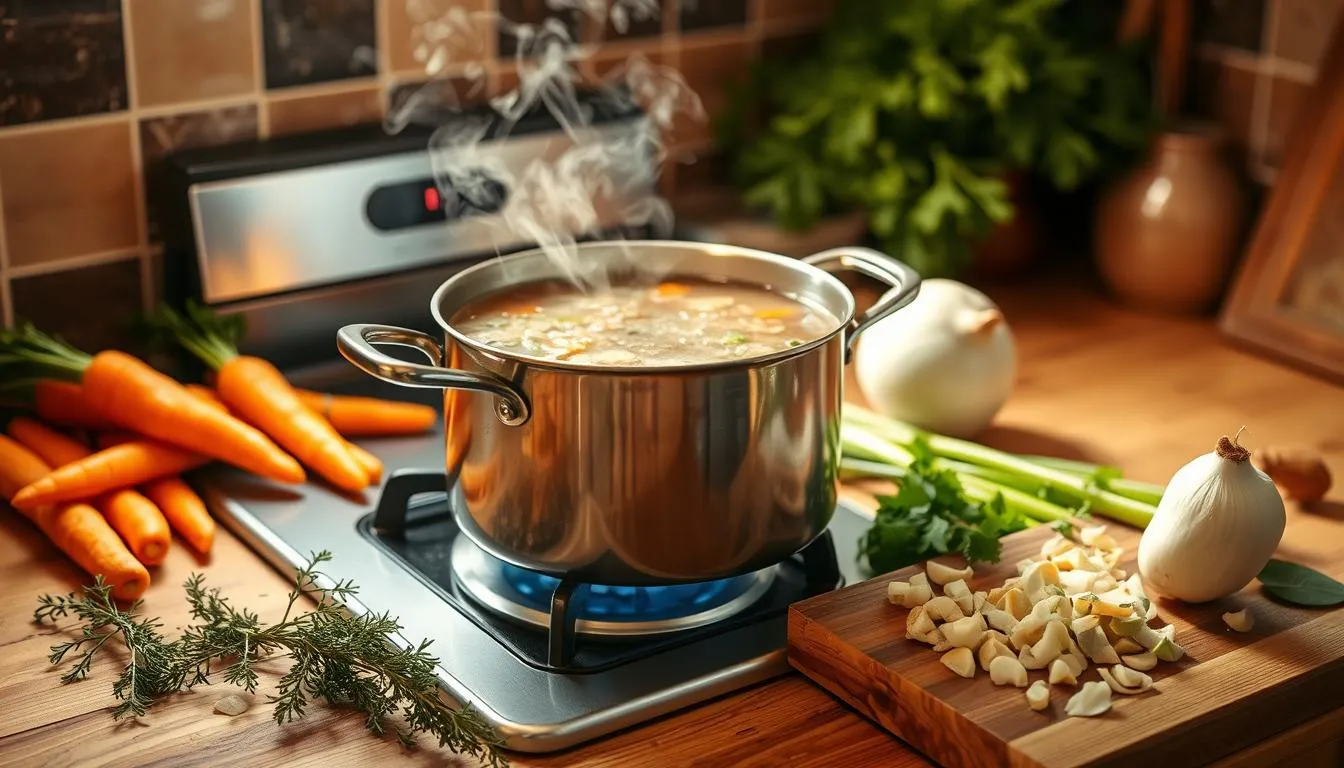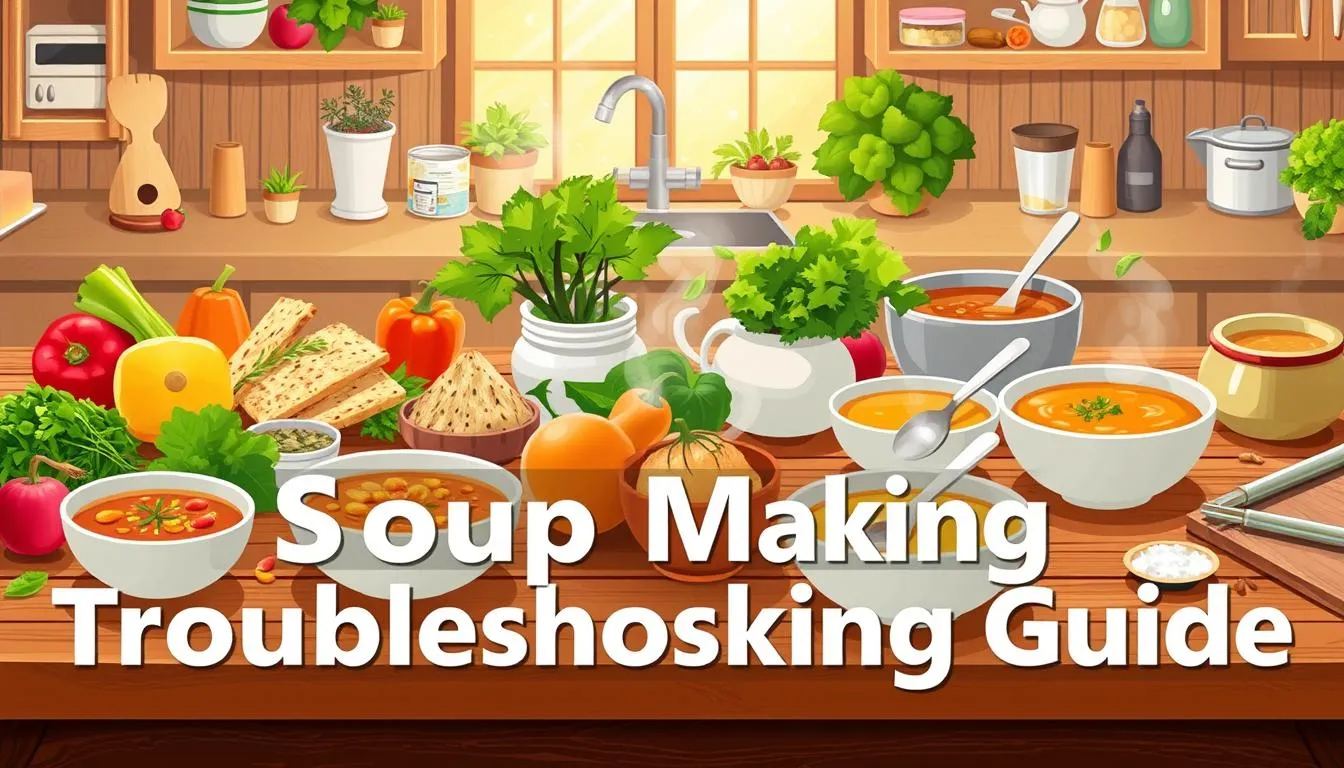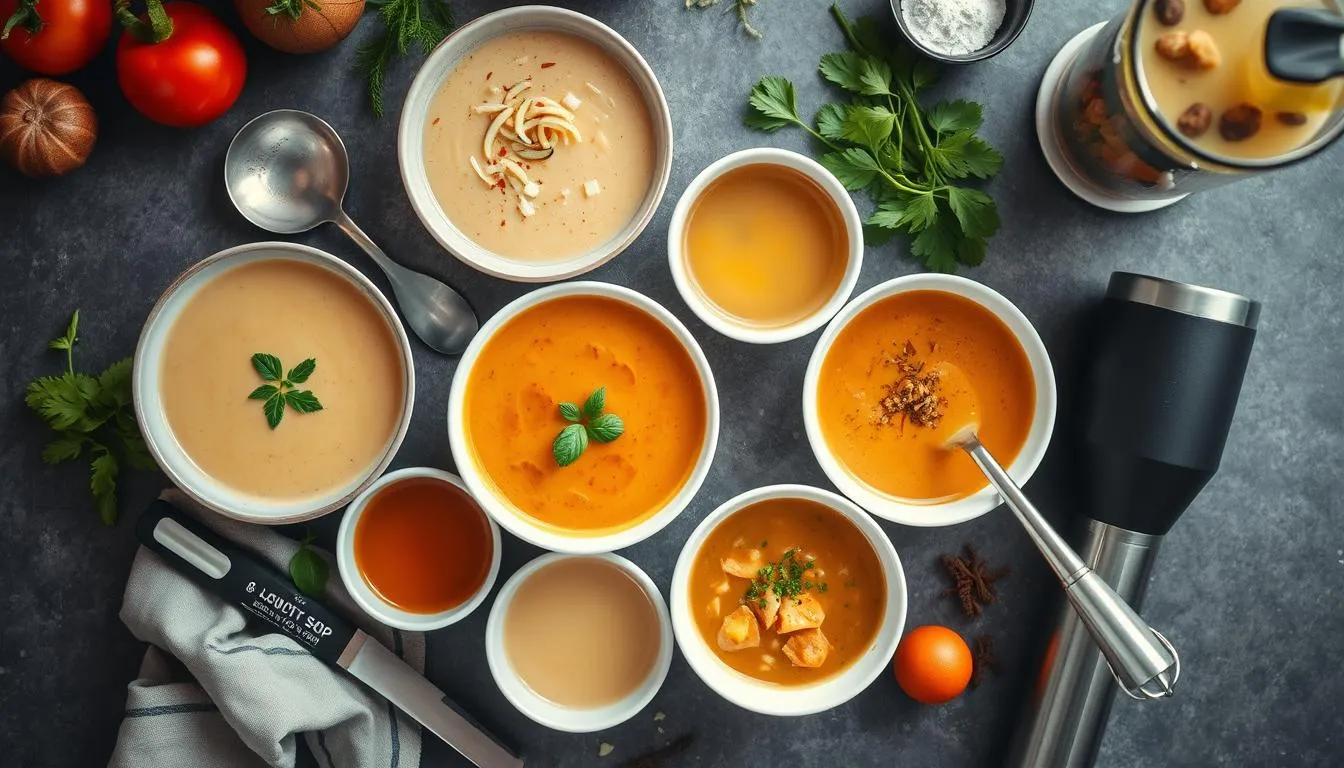Making the perfect homemade soup is like an art. It turns simple ingredients into amazing dishes. Every home cook wants to make soups as good as the pros, bringing joy and warmth to everyone who tastes it.
This soup guide will share secrets to making soups like restaurants do, right in your kitchen. It doesn’t matter if you’re new to cooking or have lots of experience. Learning the right techniques can make your soups stand out and impress everyone.
We’ll cover everything from picking the best ingredients to controlling the temperature. You’ll learn how to mix flavors, get the right texture, and make simple ingredients into unforgettable meals.
Key Takeaways
- Learn professional soup-making techniques
- Understand flavor layering fundamentals
- Master ingredient selection and timing
- Develop consistent soup texture skills
- Create restaurant-quality soups at home
The Art and Science Behind Perfect Soup Making(What is the secret ingredient in soup?)
Soup making is a mix of science and art. It’s about mastering the basics to make a meal special. Knowing how to balance ingredients, control temperature, and use cooking techniques is essential.
Professional chefs say a good soup starts with a solid base. The base’s quality sets the flavor profile of your soup.
Understanding Soup Base Foundations
A great soup base needs the right ingredients. Here are the key ones:
- Fresh vegetable or meat stock
- Aromatic vegetables like onions, carrots, and celery
- High-quality herbs and spices
- Balanced seasoning techniques
The Role of Temperature Control
Temperature is key to rich flavors. Each ingredient needs the right heat to shine.
| Ingredient Type | Recommended Temperature | Cooking Technique |
|---|---|---|
| Root Vegetables | Medium-low heat | Slow sautéing |
| Delicate Herbs | Low heat | Quick stirring |
| Proteins | Medium-high heat | Rapid searing |
Timing Your Ingredients
Adding ingredients at the right time is an art. It makes a soup go from good to great.
“In soup making, timing isn’t just important—it’s everything.” – Chef Marco Rossi
Soft veggies and herbs go in last to keep their taste and texture. Root veggies and proteins need more time to get their flavors right.
Essential Equipment for Crafting Restaurant-Quality Soups(What is the secret ingredient in soup?)
To make soups like a pro at home, you need more than just ingredients. The right tools can change your cooking game. Chefs say the right kitchen gear is key for great flavors and textures.
Here are the top tools for making amazing soups:
- Heavy-Bottom Stock Pot: The base for making soups, it keeps heat even and stops burning
- High-Performance Immersion Blender: Blends right in the pot, making soups smooth and easy to clean
- Quality Strainers and Chinois: Essential for clear broths and getting rid of solids
- Precise Digital Thermometer: Keeps cooking temperatures just right for best flavor
“The right tool can make the difference between a good soup and an extraordinary one.” – Professional Chef Mark Rodriguez
You don’t have to spend a lot on top-notch kitchen tools. Start with versatile items that can do many things. A good Dutch oven or cast-iron pot can be a workhorse, lasting long and keeping heat well.
Look for these features in your soup-making tools:
- How well it conducts heat
- How durable it is
- How easy it is to clean
- How versatile it is
With the right tools, you can turn simple ingredients into soups that wow everyone.
What is the Secret Ingredient in Soup?(What is the secret ingredient in soup?)
Every great soup has a hidden magic that makes it special. Finding the secret ingredient can take your cooking to the next level. It creates unforgettable meals that excite your taste buds.
Professional chefs know that making an amazing soup is more than just following a recipe. They use advanced flavor techniques to add depth and complexity. This makes each spoonful a delight.
Understanding Umami Enhancers(What is the secret ingredient in soup?)
Umami enhancers are the secret to a memorable soup. They add a deep flavor that makes soups stand out. Some top umami boosters include:
- Aged parmesan cheese
- Dried mushrooms
- Soy sauce
- Miso paste
The Power of Fresh Herbs
Fresh herbs can change a soup’s flavor in a big way. Culinary experts say to add herbs at different times to get the best effect. Add delicate herbs like basil and cilantro at the end. But heartier herbs like thyme and rosemary can cook for longer.
Balancing Flavors with Acid
Getting the flavors right in soup is key. A bit of acid can make the whole dish pop. Here are some acidic ingredients to try:
- Lemon juice
- Vinegar
- Tomatoes
- Wine
“The difference between a good soup and a great soup is often just a splash of acid and a handful of fresh herbs.” – Professional Chef Michael Rodriguez
By learning these tricks, home cooks can make soups that rival those in restaurants. It’s all about impressing and satisfying your guests.
Mastering the Perfect Soup Stock(What is the secret ingredient in soup?)
Making a homemade stock is key to a great soup. Professional chefs say a rich stock can turn a simple recipe into a masterpiece. To make a fantastic stock, you need to know the right techniques and choose the best ingredients.
- Choose fresh, high-quality ingredients
- Use bones with meat for more flavor
- Roast vegetables and bones before simmering
- Keep the temperature low and steady
“A great stock is the silent hero of every memorable soup.” – Culinary Expert
Each protein type needs a special approach for making stock. Let’s look at the main stock types:
| Stock Type | Key Ingredients | Ideal Simmering Time |
|---|---|---|
| Chicken Stock | Chicken bones, carrots, celery, onions | 3-4 hours |
| Beef Stock | Beef bones, roasted vegetables | 4-6 hours |
| Vegetable Stock | Mixed vegetables, herbs | 1-2 hours |
The secret to a great soup base is patience. Slow simmering pulls out the most flavor from your ingredients. This makes a rich, complex liquid that will make any soup better. Strain your stock well and store it right to keep its amazing taste.
Common Soup Making Mistakes to Avoid(What is the secret ingredient in soup?)
Soup making can be tricky, even for experienced home chefs. Knowing common soup mistakes helps you avoid pitfalls and make delicious meals. Troubleshooting soup issues requires knowledge, practice, and professional techniques.
Soup preparation involves many technical skills that can go wrong. Spotting and fixing soup issues early prevents disappointment. It ensures your soup tastes great.
Overseasoning Rescue Tactics
Overseasoning is a common problem for home cooks. If your soup is too salty or spicy, try these fixes:
- Add dairy products like cream or yogurt to neutralize intense flavors
- Incorporate unsalted stock to dilute strong seasonings
- Use acid elements like lemon juice to balance overwhelming tastes
Solving Texture Problems
Texture is key in a good soup. Troubleshooting texture means understanding how ingredients interact and cooking techniques.
- Prevent lumpy soups by gradually adding thickeners
- Use cornstarch or flour slurries for smooth consistency
- Blend ingredients carefully to maintain desired texture
Temperature Troubleshooting
Temperature control is vital in soup making. Soup mistakes often come from wrong heating or cooling.
- Use medium heat to prevent scorching
- Stir frequently to distribute heat evenly
- Allow soups to rest before serving for enhanced flavor development
“Cooking is about passion, so it may look slightly temperamental in a way that it’s too assertive to the naked eye.” – Gordon Ramsay
Professional Tips for Soup Texture and Consistency(What is the secret ingredient in soup?)
Making the perfect soup texture is an art. what sets amateur cooks apart from pros. not just about mixing ingredients. about knowing the right techniques to improve your cooking.
Professional chefs use several strategies to get the soup texture right:
- Emulsification techniques for smooth, creamy soups
- Precise reduction methods for deep flavors
- Smart use of thickening agents
Thickening agents are key for soup consistency. Chefs suggest these tips for different textures:
- Cornstarch slurry for light thickening
- Roux for rich, velvety soups
- Pureed veggies for natural thickness
“The secret to restaurant-quality soup is understanding how ingredients interact and transform during cooking.” – Michel Roux, Michelin-starred chef
Temperature control is also vital for soup texture. Slow, gentle heat keeps the soup smooth. Chefs say to use low to medium heat and stir often to avoid scorching.
Try out different techniques to find your favorite soup style. Whether it’s a silky bisque or a hearty vegetable soup, mastering these tips will change your cooking.
Seasonal Ingredients for Year-Round Soup Excellence(What is the secret ingredient in soup?)
Making tasty seasonal soups means knowing what ingredients to pick all year. Each season offers special flavors and fresh foods that make your soups stand out.
Creating the best soup is a skill that changes with the seasons. By choosing the freshest ingredients, you can improve your soup-making skills. This way, you can create unforgettable meals.
Spring and Summer Soup Ingredients(What is the secret ingredient in soup?)
Warm-weather soups are all about light, fresh tastes that capture the season’s spirit:
- Asparagus and pea soups with mint
- Chilled gazpacho with ripe tomatoes
- Zucchini and corn chowder
- Fresh herb-infused vegetable broths
“Summer soups should be as vibrant and refreshing as the season itself.” – Chef Elena Rodriguez
Fall and Winter Soup Components(What is the secret ingredient in soup?)
Cooler months need hearty, warming ingredients for comfort and nutrition:
- Butternut squash and pumpkin varieties
- Root vegetable blends
- Robust beef and lamb-based soups
- Hearty bean and lentil combinations
Storage and Preservation Methods(What is the secret ingredient in soup?)
Keeping soups fresh lets you enjoy seasonal tastes all year. Here are some tips:
- Freeze soups in portion-controlled containers
- Use vacuum-sealed bags for longer storage
- Label containers with date and ingredient details
- Store most soups for 3-4 months in the freezer
Pro tip: Let soups cool completely before storing to maintain optimal flavor and prevent bacterial growth.
Advanced Techniques for Layering Flavors(What is the secret ingredient in soup?)
Learning to layer flavors can turn simple soups into amazing dishes. Chefs know that to make soups complex, you need the right ingredients and techniques. This creates depth and richness in taste.
“Great cooking is about layering flavors, not just throwing ingredients together.” – Award-winning chef Michael Ruhlman
The first step in flavor layering is to know the basics of taste. Chefs use advanced methods to make soups more complex:
- Roasting vegetables before adding them to develop a sweet flavor
- Using spice infusions to add new flavors
- Seasoning in stages for better taste
- Adding umami-rich foods for depth
Some key techniques for amazing flavor include:
| Technique | Purpose | Flavor Impact |
|---|---|---|
| Dry Toasting Spices | Release Essential Oils | Intensifies Aromatic Qualities |
| Slow Reduction | Concentrate Flavors | Deepens Taste Profile |
| Ingredient Sequencing | Control Flavor Progression | Creates Complexity |
Chefs suggest trying new ingredient mixes. A little smoked paprika or some aged balsamic can make a soup special.
Using these advanced techniques, home cooks can make soups that taste like they’re from a restaurant. These soups will impress everyone with their complex flavors and skill.
Conclusion
Soup-making is more than just cooking—it’s an art. It turns simple ingredients into amazing meals. By honing your skills, you’ve discovered that making homemade soups needs passion, practice, and a spirit of adventure.
Learning about soup mastery means more than just following recipes. It’s about knowing how ingredients work together, controlling temperatures, and balancing flavors. Professional chefs say great soups come from a mix of intuition, skill, and respect for ingredients.
Your soup-making journey is just starting. Every pot you make is a chance to try new things and express yourself through cooking. Trust your gut, be creative, and remember, the best dishes often come from surprises in your kitchen.
As you keep improving your soup-making, you’ll grow closer to cooking. You’ll gain confidence, impress your loved ones, and turn simple meals into special moments.
FAQ
What makes a perfect soup base?(What is the secret ingredient in soup?)
A perfect soup base starts with quality stock. Choose fresh vegetables, bones, or scraps for a rich flavor. This foundation enhances your soup’s taste.
How can I prevent overseasoning my soup?(What is the secret ingredient in soup?)
Start with a little salt and seasoning. Add more as you taste. Use stock or lemon juice to balance flavors. It’s easier to add more than to take away.
What are the best tools for making professional-quality soups?(What is the secret ingredient in soup?)
Key tools include a Dutch oven, immersion blender, and strainer. A good chef’s knife is also essential. Tools like a food processor and thermometer help too.
How do I achieve the perfect soup consistency?(What is the secret ingredient in soup?)
For the right consistency, try reduction or use thickening agents. Blend or add cream for a smooth texture. Cooking time also matters.
What are some umami enhancers for soup?(What is the secret ingredient in soup?)
Umami boosters are Parmesan, mushrooms, and tomato paste. Soy sauce, miso, and anchovies also add depth. Caramelized onions are great too.
How can I preserve homemade soup?(What is the secret ingredient in soup?)
Keep soup in airtight containers in the fridge for 3-4 days. Freeze in portions for up to 3 months. This keeps the flavor good.
What are the best seasonal ingredients for soups?(What is the secret ingredient in soup?)
Spring soups use asparagus and peas. Tomatoes are perfect for summer. Fall and winter soups have root veggies and squash. Choose fresh, seasonal produce for the best taste.
How do I layer flavors in my soup?(What is the secret ingredient in soup?)
Roast veggies for depth. Use spice blends and aromatics like garlic. Finish with fresh herbs or a drizzle of oil for extra flavor.
What can I do if my soup is too thin?(What is the secret ingredient in soup?)
To thicken, simmer to reduce liquid or use a slurry. Puree veggies or add cream for a thicker soup.
How important are fresh herbs in soup making?(What is the secret ingredient in soup?)
Fresh herbs add brightness and flavor. Add delicate herbs like basil at the end. Use thyme or rosemary earlier for more flavor.





